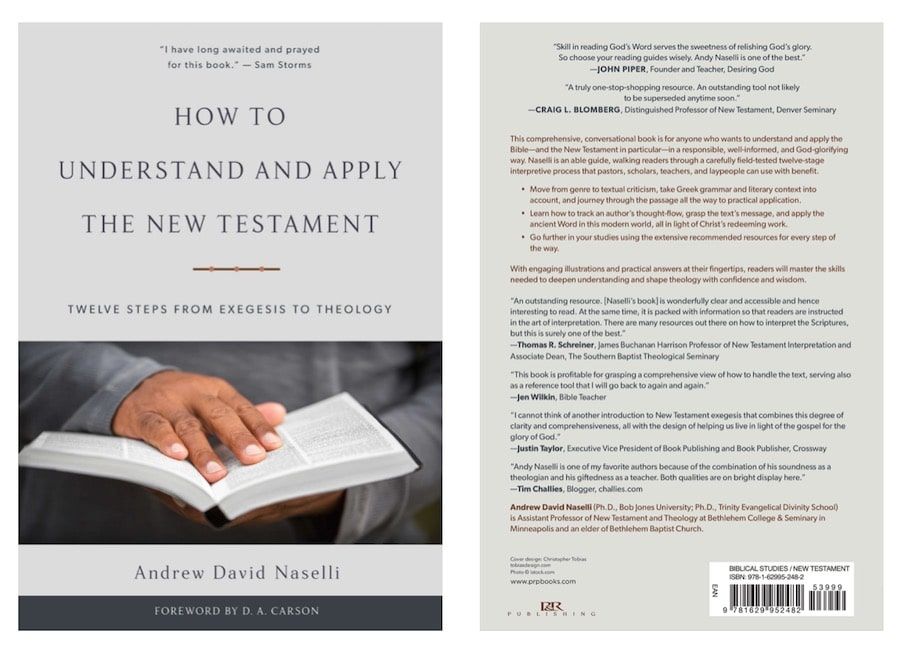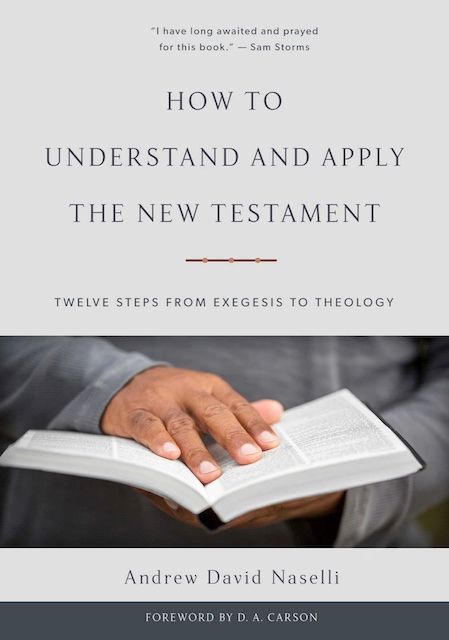How to Understand and Apply the New Testament
Andy Naselli's book on New Testament exegesis has become my favorite handbook to Bible study methods of the New Testament. Read my review on this 2017 book.

I have been following Andy Naselli’s blog for several years. His blog articles, book reviews, and books have helped me immensely. His book on New Testament exegesis is his most significant to date; it has leapfrogged to become my favorite introduction on New Testament exegesis.
1. Purpose of How to Understand and Apply the New Testament
In his preface, Naselli states that he wrote the book for Bible students, pastors, and “thoughtful Christian laypeople.” His goal is to help readers understand how to do New Testament exegesis and theology. He breaks this process down into twelve steps, writing one chapter explaining each step.
2. Content of How to Understand and Apply the New Testament
In his introductory chapter, Naselli’s defines exegesis, hermeneutics, and expository preaching. He introduces his twelve step process, but he reminds the reader that exegesis is both a science and an art. He describes the relationship between exegesis and biblical, historical, and systematic theology. He warns the reader not to neglect devotional prayer since exegesis is more than an intellectual exercise.
Chapter 1 introduces the first step to identify the genre to establish guidelines for interpretation. In this chapter, Naselli introduces 10 general hermeneutical principles. He covers how to handle figures of speech. He analyses the genre of the four gospels and Acts, and he introduces nine additional principles specific to these first five NT books. He reviews how to interpret Jesus’ parables. He highlights unique principles for interpreting epistles and the book of Revelation.
Chapter 2 covers the discipline of textual criticism, the process to establishing what is the exact, original text. This chapter explains the reality that no original NT manuscripts exists today. However, because there are thousands of copies of Greek manuscripts, ancient translations, and quotations by early church fathers, there is a discipline on how we can establish the original text. Naselli gives five practical steps on how readers can evaluate variant readings.
Chapter 3 reviews how to read and compare Bible translations. Naselli describes the qualities of a good translation, and he explains the contrast between formal equivalence (word or literal) and functional equivalence (meaning based). Special attention is given to translating figurative language and cultural issues. The issues regarding gender is also discussed. Naselli encourages readers to utilize the strengths of multiple translations.
Chapter 4 gives an overview on basic Greek grammar. Naselli covers the parts of speech, the Greek case system, participles, infinitives, and antecedent of pronouns. The goal is to help readers identify Greek syntax that is exegetically significant. He tries to condense the most important syntax discussed in Daniel Wallace’s intermediate Greek grammar in 20 pages.
Chapter 5 highlights the task of tracing the argument. He defines the term proposition, and he lists its 17 common, logical relationships. When examining a Bible passage, the reader is encouraged to identify propositions and their relationships. To accomplish this fifth step of argument tracing, Naselli reviews three graphical methods: arcing, bracketing, and phrasing. He contrasts argument tracing with sentence diagramming which examines how each word functions in a sentence. Naselli explains why phrasing is his favorite method, and he walks through his eight steps when phrasing a passage.
Chapter 6 reviews the process of understanding the historical and cultural background. Naselli discusses the importance of background study, but he also warn the reader against neglecting the perspicuity of Scripture or engage in unprofitable background speculation. Naselli introduces the concept of “mirror reading.” He also gives recommendations on what Jewish and Greco-Roman resources to use and how to use them.
Chapter 7 describes the step of looking the literary context — how a passage relates to the entire book, the New Testament, and the entire Bible. Naselli encourages readers to regularly read and listen to the entire Bible, especially the New Testament. Reading an entire book in one setting without chapter and verse divisions is another helpful discipline.
Chapter 8 uncovers the method of word study. Naselli gives four simple steps: choose a Greek word, discover its range of meanings in the New Testament, compare how it functions in the Septuagint and extra biblical Greek literature, and determine the word’s most likely meaning. Naselli finally reviewed four word study fallacies to avoid (abridged version of D.A. Carson’s second chapter of Exegetical Fallacies).
Chapter 9 begins the bridge from exegesis to theology, starting with biblical theology. Naselli begins by defining biblical theology as studying “how the whole Bible progresses, integrates, and climaxes in Christ.” He expounds on the definition. He gives several examples of topics of biblical theology. He concludes by stating that proper biblical theology requires reading the entire Bible a lot, meditating on it, and applying the “exegesis of a particular passage in its canonical context.”
Chapter 10 examines the step of historical theology — the examination of how prior exegetes have understood the Bible and theology. It encompasses a study of the early church (first century to 600), the Middle Ages (600 to 1500), the reformation and post–reformation (1500 to 1750), and the modern period (1750 to present). Naselli gives ten reasons to study historical theology, and he examines the history of Keswick theology as an example.
Chapter 11 reviews the discipline of systematic theology — the study of what the whole Bible teaches on a specific topic. Naselli reviews the benefits and dangers of studying systematic theology. To illustrate this step, he reviews two examples: the gospel and the logical problem of evil.
Chapter 12 concludes by discussing the final step of practical theology. This step involves application to the modern reader and the church today. Naselli gives six guidelines for Bible application. He highlights how the apostle Paul applies Isaiah and Job in Romans 11:34-35.
Naselli concludes the book with a strong exhortation to read and study the Bible. “Exegesis exists because worship doesn’t.”
The book contains two helpful appendices. Appendix A reviews Naselli’s method of organizing a theological library. Appendix B reviews the motivation and method for memorizing an entire New Testament book.
3. Commentary of How to Understand and Apply the New Testament
This book is structured, organized, and well written. Naselli assumes the reader may have little knowledge of theological terms, which makes this book extremely accessible. At the same time, this book is rich in detail and thoughtfulness, appropriate to be used as a first year seminary textbook.
I appreciate the key words and concepts, review questions, and bibliographies written at the end of each chapter. His bibliography is not simply a list of book names. Instead, Naselli writes several sentences describing how specific books could be a potential resource for further study.
For its length, Naselli succeeds in giving a comprehensive introduction to the essential steps of New Testament exegesis. This volume makes a great starting point for Christians desiring to refine their Bible study methodology. His up–to–date references for further study will guide most readers effectively to deeper study when desired.
4. Comparison Analysis
There are some similarities between Inductive Bible Study (Fuhr Jr. and Kostenberger) and Naselli’s book How to Understand and Apply the New Testament. Both serve as introductory textbooks on how to study the Bible. I find Inductive Bible Study more suitable for the Christian who is desiring to do personal Bible study without plans to teach and lead others in Bible study. Naselli’s book is more helpful for current and future Bible teachers.
New Testament Exegesis (by Gordon Fee) is my gold standard as a starting text for New Testament Exegesis. Fee’s book is ideal for readers who have studied at least one to two years of New Testament Greek. For seminarians and pastor teachers who will study the New Testament in Greek, Fee’s book is practically more helpful. Even though, Naselli’s devotion to connect exegesis to theology remains helpful. I recommend Naselli’s book more for individuals with fewer than two years of NT Greek study.
How to Understand and Apply the New Testament supplants two other favorite books of mine: a Handbook of New Testament Exegesis (Blomberg and Markley) and Interpreting the New Testament Text (Bock and Fanning). These two books remain helpful, and I still recommend these two books to get additional perspective on the topic of New Testament exegesis. But if I had to recommend one book today, it is Andy Naselli’s.
5. Final Thoughts
I wished I could have read this book twenty years ago, but I’m thrilled to have it today. I don’t think I will take on Naselli’s challenge of memorizing an entire NT book, but I have never been more excited to study the New Testament. Encouraged by this book, I will connect the dots from exegesis to theology and application, knowing that this pursuit should drive me to greater worship.
I recommend this book to all current and future Bible teachers who desire to update their process and methodology of New Testament exegesis. It is well worth your time and effort.

How to Understand and Apply the New Testament
by Andrew David Naselli | P&R Publishing (2017)
| Listen on Apple Podcasts | Listen on Google Podcasts |
|---|




